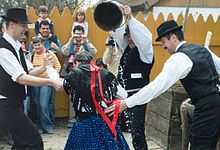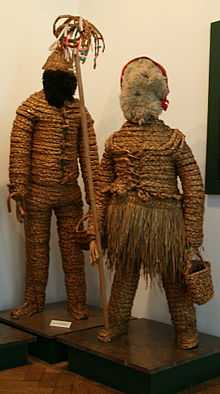Śmigus-Dyngus

Śmigus-Dyngus (also known as lany poniedziałek, meaning "Wet Monday") is a celebration held on Easter Monday in Poland. It is also observed by Polish diaspora communities, particularly among Polish Americans, who call it Dyngus Day. Similar celebrations are held in the Czech Republic and Slovakia (Oblévačka in Czech, Oblievačka in Slovak, both meaning "Watering") and in Hungary, where it is known as Vízbevető or "Water Plunge Monday". Traditionally, boys throw water over girls and spank them with pussy willow branches on Easter Monday, and girls do the same to boys on Easter Tuesday. This is accompanied by a number of other rituals, such as making verse declarations and holding door-to-door processions, in some regions involving boys dressed as bears. The origins of the celebration are uncertain, but it may date to pagan times (before 1000 AD); it is described in writing as early as the 15th century. It continues to be observed in central Europe, and also in the United States, where certain patriotic American elements have been added to the traditional Polish ones.
Activities

The festival is traditionally celebrated by boys throwing water over girls they like and spanking them with pussy willows.[1] Boys would sneak into girls' homes at daybreak on Easter Monday and throw containers of water over them while they were still in bed.[2] This was usually accompanied by a rhyme; in the Polish-American community of Pine Creek, Wisconsin, the boys would chant Dyngus, dyngus, po dwa jaja; nie chce chleba tylko jaja[3] ("Dyngus, dyngus, for two eggs; I don't want bread but eggs").[4] After all the water had been thrown, the screaming girls would often be dragged to a nearby river or pond for another drenching.[2] Sometimes a girl would be carried out, still in her bed, before both bed and girl were thrown into the water together.[5] Particularly attractive girls could expect to be soaked repeatedly during the day.[6] The use of water is said to evoke the spring rains needed to ensure a successful harvest later in the year.[5] Girls could save themselves from a soaking by giving boys "ransoms" of painted eggs (pisanki), regarded as magical charms that would bring good harvests, successful sexual relationships and healthy childbirths.[2] Although in theory the girls are supposed to wait until the following day to get their revenge by soaking the boys, in practice both sexes throw water over each other on the same day.[5]
Pussy willows appear to have been adopted as an alternative to the palm leaves used elsewhere in Easter celebrations, which were not obtainable in Poland. They were blessed by priests on Palm Sunday, following which parishioners whipped each other with the pussy willow branches, saying "Nie ja bije, wierzba bije, za tydzień, wielki dzień, za sześć noc, Wielkanoc" ("It's not me who strikes, the willow strikes, in a week, holy week, in six nights, Easter"). The pussy willows were then treated as sacred charms that could prevent lightning strikes, protect animals and encourage honey production. They were believed to bring health and good fortune to people as well, and it was traditional for three pussy willow buds to be swallowed on Palm Sunday to promote good health. As with the water-throwing, boys would whip girls with pussy willows on Easter Monday and girls would do the same to boys on the following Tuesday.[7]
The celebration would traditionally be accompanied by declarations in verse, in which a young man would climb on the roof of a building in the village, beat on a tin pan and announce which girls were to be doused along with how many wagon-loads of sand, how much water and how much soap would be used on each girl. The girls would also respond in verse, announcing that there was someone who would save her. For instance,
From the tavern roof would come the announcement that Zośka, because she dressed badly, kept her house untidy, and quarreled with everyone, will have a Dyngus of a hundred barrels of water, a hundred cartloads of sand and a hundred lashes. Then from a window would come the reply that Zośka is not frightened because Jasiek stands beside her with a bottle of whiskey to buy off all assailants and ransom her off from the penalty.[8]

A Dyngus procession would also be held, either on Easter Monday or Tuesday. A parade of boys would take part in a march known as chodzenie po dyngusie – "going on the Dyngus" – or z kogutkiem – "with the cockerel", a reference to the use of a live bird, usually taken without permission and stuffed with grain soaked in vodka to make him crow loudly. (A decorated and carved wooden rooster was sometimes used as an alternative.) The rooster was a symbol of fertility, carried on a small two-wheeled wagon which had been painted red and decorated with ribbons and flowers, to which was often also added small puppets representing a wedding party. This would be pushed from door to door by the boys, who would crow like roosters and sing Dyngus songs conveying good wishes and requests for gifts and food.[9] Their objective was to encourage the inhabitants to give them food from their Easter tables, such as Easter eggs, ham and sausages.[10] A typical Dyngus song went:
Your duck has told me
That you've baked a cake
Your hen has told me
She's laid you a basket and a half of eggs
Your sow has told me that you've killed her son
If not her son then her little daughter
Give me something if only a bit of her fat
Who will not be generous today
Let him not count on heaven.[1]
Cite error: There are<ref>tags on this page, but the references will not show without a{{reflist}}template (see the help page).
In some regional variants of po dyngusie, the boys would march through the village with one of their number dressed as a bear with a bell on his head – either wearing a real bearskin or a stand-in made of pea vines. The group would go from door to door collecting "gifts for the bear" before "drowning" the bear in a nearby stream or pond. This was probably an adaptation of a traditional ceremony to drown a straw figure of Marzanna, the spirit of winter.[11] The "bears" were often invited in as they were believed to ensure that there would be a good harvest, reflecting a very ancient belief in the power of the bear to prevent evil, encourage crop growth and cure diseases. In Mazowsze and Małopolska, boys wearing bearskins would also chase girls.[10]
Girls had their own version of po dyngusie in which they would go from door to door carrying a freshly cut green branch or gaj, seeking food and singing songs welcoming the "new year" that followed Easter:
Our green little tree, beautifully decked
Goes everywhere
For it is proper that it should
We go with it to the manor house
Wishing good fortune, good health
For this new year
Which God has given us.[1]
Cite error: There are<ref>tags on this page, but the references will not show without a{{reflist}}template (see the help page).
Families would also visit each other on the same day to deliver presents of Easter eggs or rolls, receiving in return gifts of food from the Easter table.[12]
Origins and etymology
The celebration has been traced back to the 15th century but may have earlier, pre-Christian origins involving the celebration of the March equinox;[13] The origins of the word Dyngus are obscure; it may come from the German dingeier ("the eggs that are owned") or dingnis ("ransom").[12] The occurrence of the celebration across the western Slav countries (plus Hungary, whose inhabitants' forebears conquered a formerly Slav-inhabited region) suggests a common origin in pagan mythology, most likely a link with the Slavic goddesses of fertility. It may possibly be related to the tradition of watering the Corn Mother, who made crops grow and was represented in the form of a doll or wreath made from corn. This would be symbolically drenched in water and kept over the winter until its grain was mixed with the seed corn in the spring to ensure a successful harvest. In time, the growing influence of Christianity in Poland incorporated the Dyngus celebrations, along with other pagan practices, into Christian festivals like Easter Monday.[14]
Some have suggested that the use of water is an allusion to the baptism of Mieszko I, the Duke of Polans (c. 935–992) in 966 AD, uniting all of Poland under the banner of Christianity.[6] The New Cambridge Medieval History, however, suggests it that originated far to the west of Poland and was adopted under German influence.[15] Originally śmigus and dyngus were two separate events, with śmigus involving the act of throwing water (oblewanki), and dyngus, bribing people with pisanki to escape from śmigus; later both traditions merged.[13] Attempts have been made to curtail it; in 1410 it was forbidden by the Bishop of Poznań in an edict titled Dingus Prohibitur, which instructed residents not to "pester or plague others in what is universally called Dingus"[2]
Dyngus Day in America
Dyngus Day is observed in many Polish American communities, most notably in Buffalo, New York, which hosts the largest continuing event commemorating the day.[6] The Buffalo Dyngus celebrations only started in the 1960s as an effort by the Polish-American community in the city to find a new focus for its identity. It proved hugely successful, to the point that a local newspaper claimed that "everybody is Polish on Dyngus Day."[16] It has become a fusion of Polish and American traditions, with polka bands, a parade, and Polish food accompanying American patriotic songs sung in English.[17] Party-goers dress up in the red-and-white colours of the Polish flag and carry balloons saying "Happy Dyngus Day" in English.[18]
Dyngus Day is also celebrated annually in La Porte Indiana, people from La Porte and many visitors come to the city. Each bar is a bus stop for the day to ferry people to each bar.
References
| Wikimedia Commons has media related to Category:Wet Monday. |
- ↑ Silverman, Deborah Anders (2000). Polish-American Folklore. University of Illinois Press. pp. 34–38. ISBN 9780252025693.
- ↑ 2.0 2.1 2.2 2.3 Silverman, Deborah Anders (1997). "Creative Ethnics: Dyngus Day in Polish American Communities". In Tuleta, Tad. Usable Pasts: Traditions and Group Expressions in North America. Utah State University Press. ISBN 0-87421-226-X.
- ↑ Malicki L.: Rok obrzędowy na Kaszubach, Wojewódzki Ośrodek Kultury, Gdańsk 1986, p. 39
- ↑ Malinowski, Michał; Pellowski, Anne (2008). Polish Folktales and Folklore. Libraries Unlimited. p. 45. ISBN 9781591587231.
- ↑ 5.0 5.1 5.2 Benet, Sula (1951). Song, Dance and Customs of Peasant Poland. London: Dennis Dobson. p. 57.
- ↑ 6.0 6.1 6.2 Melton, J. Gordon (2011). Religious Celebrations: An Encyclopedia of Holidays, Festivals, Solemn Observances, and Spiritual Commemorations. ABC-CLIO. p. 271. ISBN 9781598842050.
- ↑ Silverman (1997), pp. 69–70
- ↑ Benet, pp. 57–58
- ↑ Benet, p. 58
- ↑ 10.0 10.1 Silverman (1997), p. 70
- ↑ Benet, p. 59
- ↑ 12.0 12.1 Silverman (1997), p. 72
- ↑ 13.0 13.1 Skąd się wziął śmigus-dyngus?, dziennik.pl, 2009-04-10
- ↑ Silverman (1997), p. 73
- ↑ Rowell, S.C. (1999). "The central European kingdoms". In Abulafia, David. The New Cambridge Medieval History. Cambridge University Press. p. 776. ISBN 9780521362894.
- ↑ Silverman (1997), p. 81
- ↑ Silverman (1997), p. 83
- ↑ Silverman (1997), p. 85